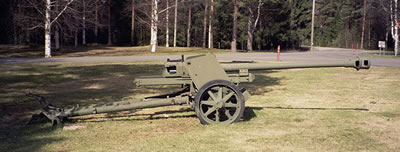In 1939, Germany began working on the development of a 75mm anti-tank gun to counter predicted increases in armor thickness. Rheinmetalls’s design of the 7.5 cm Pak 40 was accepted by the Germans in 1940. Production of the Pak 40 anti-tank gun began in 1942.
The Pak 40 was essentially a larger version of the Pak 38. However, while the Pak 38 had curved shield plates, the plates for the Pak 40 shield were flat.
In addition, the Pak 40 had a steel carriage rather than a carriage made of light alloys. This was because there was a shortage of light alloys, and those that were available were allocated to aircraft production.
The use of steel increased the weight of the Pak 40, which weighed about 3,300lb (1,500kg) when carriage mounted, making it far heavier than earlier anti-tank guns.
 A Pak 40 could penetrate 6 inches (154mm) of armor at 1094 yards (1000m) when firing AP40 ammunition from a 46 caliber barrel. High explosive rounds were introduced for the Pak 40.
A Pak 40 could penetrate 6 inches (154mm) of armor at 1094 yards (1000m) when firing AP40 ammunition from a 46 caliber barrel. High explosive rounds were introduced for the Pak 40.
23,303 Pak 40s were produced from 1942 until April 1945.
However, despite this large figure, supply never quite met demand. Pak 40s were often lost in frontline battles. Sometimes, Pak 40s were abandoned during rapid troop withdrawals because the guns were too heavy to move quickly. In addition, the Pak 40s needed to be towed by vehicles that could be damaged themselves.